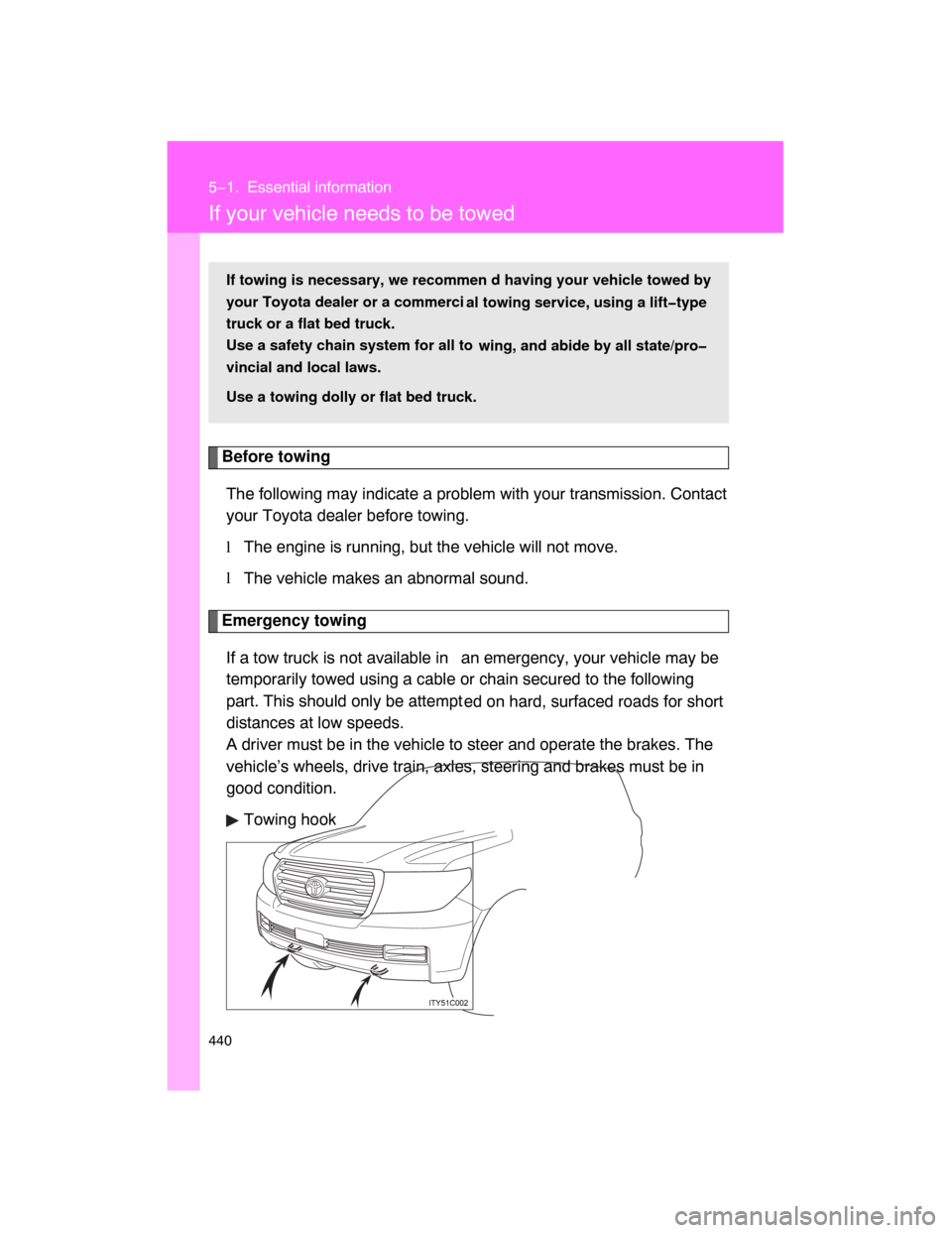Page 232 of 531

234 2−5. Driving information
lNote that when making a turn, the trailer wheels will be closer than
the vehicle wheels to the inside of the turn. Compensate by making
a larger than normal turning radius.
lCrosswinds and rough roads will adversely affect handling of your
vehicle and trailer, causing sway
. Periodically check the rear to
prepare for being passed by large trucks or buses, which may
cause your vehicle and trailer to sway. If swaying occurs, firmly grip
the steering wheel, reduce speed immediately but gradually, and
steer straight ahead. Never increase speed. If you make no
extreme correction with the stee ring or brakes, your vehicle and
trailer will stabilize.
lTake care when passing other vehicles. Passing requires consider−
able distance. After passing a vehi
cle, do not forget the length of
your trailer, and be sure you hav e plenty of room before changing
lanes.
lIn order to maintain engine braking efficiency when driving on a
long steep downgrade, do not use overdrive. Transmission shift
range position must be in “4”, in “S” mode.
lDue to the added load of the trailer, your vehicle’s engine may
overheat on hot days (at temperatur
es over 85°F [30°C] when driv−
ing up a long or steep grade. If the engine coolant temperature
gauge indicates overheating, immediately turn off the air condition−
ing (if in use), pull your vehicle off
the road and stop in a safe spot.
( P. 488)
Page 233 of 531

235
2−5. Driving information
2
When driving
lAlways place wheel blocks under both the vehicle and the trailer
wheels when parking. Apply the parking brake firmly, and put the
transmission in “P”. Avoid parking on a slope, but if unavoidable,
do so only after performing the following:
Apply the brakes and keep them applied.
Have someone place wheel bloc
ks under both the vehicle and
trailer wheels.
When the wheel blocks are in pl
ace, release the brakes slowly
until the blocks absorb the load.
Apply the parking brake firmly.
Shift into “P” and turn off the engine.
lWhen restarting after parking on a slope:
With the transmission in the “P ” position, start the engine. Be
sure to keep the brake pedal pressed.
Shift into “3”, “2”, “1”, or “R” position (if reversing).
Release the parking brake and
brake pedal, and slowly pull or
back away from the wheel blocks. Stop and apply the brakes.
Have someone retrieve the blocks.
STEP1
STEP 2
STEP 3
STEP 4
STEP 5
STEP 1
STEP 2
STEP 3
STEP 4
Page 234 of 531

236 2−5. Driving information
nBefore towing
Check that the following conditions are met:
lThe vehicle’s tires are properly inflated.
lTrailer tires are inflated according to the trailer manufacturer ’s recom−
mendation.
lAll trailer lights work.
lAll lights work each time you connect them.
lThe trailer ball is set up at the proper height for the coupler on the trailer.
lThe vehicle remains level when a loaded or unloaded trailer is hitched.
Do not drive if the vehicle is not level, and check for improper tongue
load, overloading, worn suspension, or other possible causes.
lThe trailer cargo is securely loaded.
lThe rear view mirrors conform to all applicable federal, state/provincial or
local regulations. If they do not, install rear view mirrors appropriate for
towing purposes.
nBreak�in schedule
Toyota recommends that you do not use a new vehicle or a vehicle with any
new power train components (engine, transmission, differential, wheel bear−
ings, etc.) to tow a trailer for the first 500 miles (800 km) of driving.
nMaintenance
lIf you tow a trailer, your vehicle will require more frequent maintenance
due to the additional load. (See “Scheduled Maintenance Guide” or
“Owner ’s Manual Supplement”.)
lRetighten the fixing bolts of the towing ball after approximately 600 miles
(1000 km) of trailer towing.
Page 363 of 531
368 4−2. Maintenance
Vehicle interior
Items Check points
Accelerator pedal�Moves smoothly (without uneven
pedal effort or catching)?
Automatic transmission “Park”
mechanism�Can the vehicle be hold securely
on an incline with the shift lever in
“P”?
Brake pedal�Moves smoothly?
�Does it have appropriate clear−
ance and correct amount of free
play?
Brakes�Pulls to one side when applied?
�Loss of brake effectiveness?
�Spongy feeling brake pedal?
�Pedal almost touches floor?
Head restraints�Move smoothly and lock
securely?
Indicators/buzzers�Function properly?
Lights�Do all the lights come on?
�Headlights aimed correctly?
Parking brake�Moves smoothly?
�Can hold the vehicle securely on
an incline?
Seat belts�Does the seat belt system oper−
ate smoothly?
�Are the belts undamaged?
Seats�Do the seat controls operate
properly?
Steering wheel
�Moves smoothly?
�Has correct free play?
�No strange noises?
Page 367 of 531
372 4−3. Do−it−yourself maintenance
ItemsParts and tools
Power steering fluid (
P. 386)�Automatic transmission fluid
DEXRON
®II or III
�Rag or paper towel
�Funnel (used only for adding
power steering fluid)
Radiator and condenser (P. 383)
Tire inflation pressure (P. 401)�Tire pressure gauge
�Compressed air source
Washer fluid (P. 390)�Water
�Washer fluid containing antifreeze
(for winter use)
�Funnel (used only for adding
washer fluid)
Page 381 of 531
386 4−3. Do−it−yourself maintenance
Power steering fluid
nFluid level
The fluid level should be within the appropriate range.
Full (when hot)
Add fluid (when hot)
Full (when cold)
Add fluid (when cold)
Hot:Vehicle has been driven around 50 mph (80 km/h) for 20 min−
utes, or slightly longer in frigid temperatures. (Fluid tempera−
ture, 140°F − 175°F [60°C − 80°C]).
Cold:Engine has not been run for about five hours. (Room temper−
ature, 50°F − 85°F [10°C − 30°C]).
n
Checking the fluid level
Make sure to check the fluid type and prepare the necessary items.
Clean all dirt off the reservoir.
Remove the cap by turning it counterclockwise.
Wipe the dipstick clean.
Reinstall and remove the reservoir cap again.
Check the fluid level.
1
23
4
ITY43C070
Fluid type Automatic transmission fluid DEXRON® II or III
Items
Rag or paper, Clean funnel (only for adding fluid)
STEP1
STEP 2
STEP 3
STEP 4
STEP 5
Page 434 of 531

440
5−1. Essential information
If your vehicle needs to be towed
Before towing
The following may indicate a problem with your transmission. Contact
your Toyota dealer before towing.
lThe engine is running, but the vehicle will not move.
l
The vehicle makes an abnormal sound.
Emergency towing
If a tow truck is not available in an emergency, your vehicle may be
temporarily towed using a cable or chain secured to the following
part. This should only be attempt
ed on hard, surfaced roads for short
distances at low speeds.
A driver must be in the vehicle to steer and operate the brakes. The
vehicle’s wheels, drive train, axles, steering and brakes must be in
good condition.
Towing hook
If towing is necessary, we recommen d having your vehicle towed by
your Toyota dealer or a commerci
al towing service, using a lift�type
truck or a flat bed truck.
Use a safety chain system for all to
wing, and abide by all state/pro�
vincial and local laws.
Use a towing dolly or flat bed truck.
Page 435 of 531
5
When trouble arises
441 5−1. Essential information
nEmergency towing procedure
The engine must be in ACCESSORY mode (engine off) or IGNI−
TION ON mode (engine running).
Put the four−wheel drive control switch in “H4”. (The center differen−
tial is unlocked.)
Put the shift lever in “N”.
Release the parking brake.
CAUTION
nWhile towing
lUse extreme caution when towing the vehicle.
Avoid sudden starts or erratic driving maneuvers which place excessive
stress on the emergency towing hook and the cable or chain.
lIf the engine is not running, the power assist for the brakes and steering
will not function, making steering and braking more difficult.
NOTICE
nTo prevent causing serious damage to the transmission
lNever tow this vehicle wheels on the ground.
l
Use only the front emergency towing hooks or towing eyelets (depending
on vehicles) when towing your vehicle.
STEP1
STEP 2
STEP 3
STEP 4